











  |
 |
 |
 |
 |
|||
  |
 |
 |
 |
 |
|||

after the whirlwind, |
|
|||
|
|
||||
|
new! Cathedrale Saint-Gatien at Tours
the perpendicular or English style of cathedral the fire at the cathedral of Notre-Dame de Paris Stone tracery in church and
cathedral construction stained glass and cathedrals in Normandy fortified churches, mostly in Les Landes cathedral labyrinths and mazes in France Germans in France on first arriving in France - driving Transbordeur bridges in France and the world 2: focus on Portugalete, Chicago,
Rochefort-Martrou France’s western isles: Ile de Ré Ile de France, Paris: in the context of Abelard and of French cathedrals Marianne - a French national symbol, with French definitive stamps la Belle Epoque
Pic du Midi - observing stars clearly, A64 Futuroscope the French umbrella & Aurillac 50 years old:
Citroën DS the forest as seen by Francois Mauriac, and today bastide towns
|
||||
 |
|||||
the whirlwindAt four a.m. [04:00] on Saturday, 23rd January 2009, the landscape of the Department of Les Landes was changed for perhaps the next hundred years.
The winter storm Klaus, an extra-tropical cyclone originating in the Bay of Biscay, swept in from the Atlantic and across southern France and northern Spain, reaching northern Italy and even the Adriatic Sea. A band of strong [60km/h] high-level [9 kilometres up] winds - a jet streak - descended over the Bay of Biscay, stretching from the East Atlantic to western Europe. Ground level wind speeds were recorded at 180 km/h [113 mph] as the cyclone wind first hit the coast. The coastal protective dunes deflected the force of the cyclone up, and it descended with accumulated speed and force on the interior of the department. There, in the heart of the forest, in places like Rion-des-Landes, Villenave and Suzan, the cyclone descended at a speed of 210 km/h [130 mph]. The mature pines, thirty to forty years old and approaching their harvesting time, were felled or broken; many younger trees were uprooted, but still standing, leaning against their neighbours. Storm Klaus caused widespread destruction: building damage, power outages, flooding and travel disruption. It tore off roofs, toppled and broke electric and telephone pylons and towers, and above all in Les Landes, it downed hundreds of thousands of trees. There were also at least twenty deaths, including at a primary school in north Spain. The storm’s effects were felt from Barcelona to the Channel Islands.
One Landais mayor commented that the storm in 1999 was a joke compared to the 2009 storm. damage to the infrastructure
Thousands of reinforced concrete pylons were not toppled, but were snapped and bent in one or more places, leaving cat’s cradle tangles of cables strewn on the fallen trees and the ground. It took until 5th February, for all households to be provided with some sort of temporary power supply. Many remote homesteads in the forest, as well as isolated hamlets, have been provided with generators from 100kW to 600kW power - over eight hundred have been made available.
Bordeaux, Biarritz and Pau airports were closed and train services in the Aquitaine and Midi-Pyrenees regions were stopped entirely. Because the widespread loss of power, and also because of damage to pylons and sub-stations, much of the mobile phone and land-line phones were out of action, in some places for almost two weeks. abelard.org had no mains electricity from Saturday 23rd January until Tuesday 3rd February (11 days), and only then because a long temporary power cable was laid down from the village centre through the devastated forest, over the fallen trunks, and connected to the house. The permanent aerial line was not re-installed until three months later, after the dozens of pines in this part of the forest were cleared away and the job rose to the top of the electricity company’s roster. Now, 21 months later, the power cables, that previously lined the 15 or more kilometres of road running northwards from the local conurbation, have been buried (and the ugly pylons have been removed). Thus, if there is a next time, there will not be such a widespread deprivation of power.
|
|||||
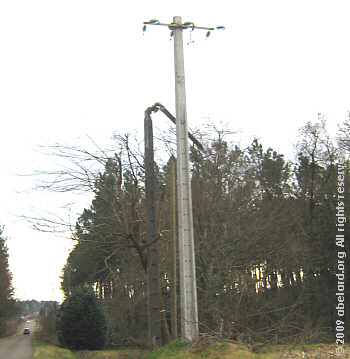 |
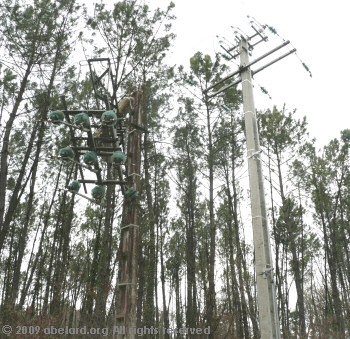 snapped off pylon alongside replacement |
||||
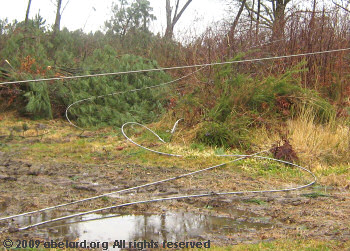 |
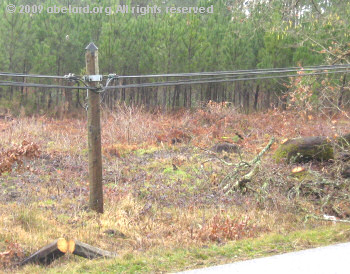 |
||||
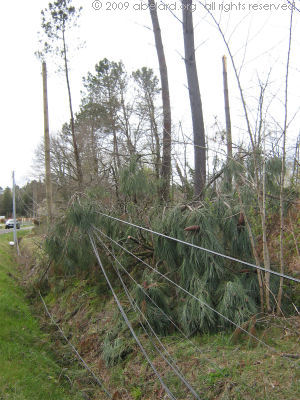 |
 |
||||
the cost
damage to the forest
The first estimations in France are that between 30 to 50 million cubic metres of trees, mainly pine and poplar, were felled by the storm. It is now estimated that perhaps 60% to 70% of pine forest were felled in Aquitaine - quite disastrous for its lumber industry. The estimation is that the amounts knocked over correspond to eight years, more or less, of normal wood consumption. It would be intended mainly for the packaging and paper industries and for wood energy. Now, because the current global economic difficulties, there is great concern that there will be little market for the wood, particularly pinewood. For instance, the Spanish wood market was closed last summer. This knock down will glut the market for many years, so the prices will go way down just to get rid of the surplus lumber. The lumber becomes next to valueless if it is not cleared from the damp forest environment, becoming a haven for fungi which spoil and damage the wood. Furniture quality timber, from more mature trees, must be cleared from the forest floor within two to three years. Younger, smaller trees can be left for six to seven years, their timber being used for paper and other processed wood products, as well as for biomass. In 1999, provision was made for managed storage of about one million cubic metres of timber being stocked. Current discussions suggest that, this time, ten million cubic metres of lumber will need long term storage. In 1999, the last large storm here, 27 million cubic metres of trees fell. It was not as devastating as the 2009 storm, and took ten years to clear up, adding much additional work to the usual logging industry. This time, it will take at least five years to remove the broken and fallen trees, and maybe a further fifteen years to reestablish the forest. It could take a century before the Aquitaine forest can return to its former majesty after the current chaos.
ips sexdentatus - the scourge after the cyclone
As following the vicious storm of 1999, the Aquitaine forest is now (mid-2010) being severely hit by another disaster - a bark burrowing beetle called, in Latin, the ips sexdentatus and nicknamed ‘the stenographer’, because of distinctive patterns left in dead trees by both their egg-laying and larval tunnels created under the tree’s bark. Another French name is le catchote, while the most commonly used name is scolyte.
This insect infestation started in September 2009, benefiting from the manna of green wood on the ground. Stopped by the winter when the beetle is in ‘diapause’, the infestation proliferated ever more strongly in Spring 2010 as temperatures rose above 15°C. Spring weather in 2010 was been propitious for ips breeding, then it taking six weeks for another generation to appear. By July, that period had reduced to four weeks. Until recently, the invasion was confined to fallen wood. Now that ‘food’ is exhausted, the insects attack standing, healthy pines. It is estimated that three to six, maybe even ten, million cubic metres of wood are affected so far. The damage can be added to the direct destructive toll wreaked by Cyclone Klaus of 40 million cubic metres. how the ips kills pine treesFrom a distance, the pines appear brown and burnt. Close up, there are little round holes, about 1 to 2 mm across,
in the pine bark and, sometimes, sawdust and wormholes.
The insects dig these little holes in the bark, then the larvae develop under the bark, eating the phloem, or food-conducting tubes. The tree loses its ability to transport sap, particularly from the needles towards the roots. Because of this, the trees dry out very quickly, especially in warm weather. (Remember, there were several hot periods - up to about 38°C/100°F - during the summer of 2010.) After any great climatic event, there are plant pest
problems. This time, the areas killed by the scylotes
(scavenger insects) were initially similar to the regions
damaged by Cyclone Klaus. But maps drawn up by the Department
of Forest Health in June this year show that the scylote
damage is more extensive than that of after the 1999 storm.
Then, about 2-3 million m3 of wood were lost
to ips sexdentatus. In June 2010, the first evaluation
showed about 1.5 million m3 had been lost since
Klaus. However, the attacks of summer and autumn, reinforced
by the favourable weather, mean that the insects have
been rife in the forest. While one must wait until the
end of autumn to evaluate the damage’s extent, already
the damage is estimated at a loss of between 5 to 8 million
m3 of wood. The ravages of the tiny beetles constrain the sylviculturers, the foresters, to cut the trees down prematurely. Once cut, the wood losses value quickly, the ips infecting the wood with a blue-staining fungus. Thus the wood can only be used for less value end-products, such as cardboard, chipboard and paper pulp, rather than higher quality products such as parquet and timber cladding or planking. This has dropped the wood’s price again 5 to 10 times, as happened just after Cyclone Klaus in January 2009. In order to rid their pines of this scourge, sylviculturers usually cut the whole parcel containing infected trees, rather than just thinning out those that have been clearly attacked. Thinning provides plenty of fresh cut wood smell, which attracts the ips to attack the remaining pines in the parcel. And there is no authorised chemical treatment to eradicate beetles in the trees. The pine forest monoculture leaves the spread of invasive infections to be rapid and pervasive. Only if the Aquiatine foresters, brought up on over 150 years of harvesting a single plant, plant a variety of tree species, putting sufficient deciduous trees near or amongst the pines, will the next cycle of magnificent trees be able to withstand this, and other, scourges.
processionary caterpillars
The pine processionary caterpillar is the larva of the Thaumetopoea pityocampa moth. The larva or caterpillars live in tent-like nest high in the pines, marching out in a line, nose to tail, usually at night, to find food. When they are ready to pulpate, they descend to the ground and bury themselves just under the surface of the soil.
The intensity of damage is highly variable. The caterpillar colonises preferentially sunny edges of well-packed plantations, as well as open woodland and clearings. With mature forest, even total defoliation does not kill the tree. If growing conditions are, favorable, the trees are perfectly capable of withstanding such an attack. However, young plantations or those weakened by disease can suffer repeated and lasting defoliation. Being weaker, they will be less resistant to parasite attacks. These caterpillars are very hairy, the hairs having a highly irritating poison. Thus even the the slightest touch can cause extreme irritation and even allergic reactions. Do not directly touch a processionary caterpillar. Note that the stinging hairs can also be carried by the wind. A French entomologist, Jean Henri Fabre [1823-1915], did a famous experiment where he enticed a column of processionary caterpillars to form a circle. The caterpillars continued to walk round in the circle for over a week.
Taxonomic
rank of Thaumetopoea pityocampa
one year later
two years after a forest’s destructionAfter two years, the assessment of the havoc wreaked by a freak hurricane-strength cyclone can be more complete, showing clearly the extensive ruination of Europe’s largest industrial forest.
It is probable that most of the devastated land will be replanted as forest, even though it will be ten, or even twenty years before there can again be some real semblance of a healthy, functioning forest. Although a few have taken the opportunity of cleared forest and insurance compensation to install photovoltaic farms, or in one case, a duck farm for foie gras, for most foresters, the pine sap is in their blood and their drive is to rebuild the life they know and love. Remember, with trees that can take fifty, sixty or even more years to be felled, many foresters were born amongst young trees and have lived all their lives deep in this great forest, in the swaying black columns of a natural cathedral, roofed by rustling viridian needles. (More at the forest as seen by Francois Mauriac, and today.) There is the further factor that the other main use of this sandy, meagre soil - maize production - requires much time and labour during several periods of the year and completely different equipment, as well as sufficient water. And this last is starting to be rationed as water demand becomes greater and rainfall less. two years of intense activity in the forest
revised costs
three years since the whirlwindThe devastation is now reckoned to be at least as bad as that wrecked by the successive and murderous forest fires from 1945 to 1950, which was when over 300,000 hectares were consumed. It was after these fires that the vast network of fire breaks, and associated water points, was created. The wide fire breaks not only make it more difficult fo fires to spread through the forest massif, but also provides efficient access for firemen and their vehicles into the heart of the largest industrial forest in Europe. After the Aquitaine forest cut down by the ferocious Cyclone Klaus, the forest was then been ravaged by ips sexdentatus bark-boring beetles, who destroyed between 7 and 8 million cubic metres of wood, and then by processionary caterpillars. To help control the beetle attacks, 120,000€ has been released for treating the piles of wood so often seen at the side of foretsry roads. For the twitching types, it has been noted that the wood piles are also infected by the pine hylesine (Tomicus sp.). This beetle is smaller than the ips, being only 4 to 5 mm long. In 2012, more funds have been released to subsidise the clearing and replanting smaller forestry plantations, mainly for those those of less than 5 hectares. What was once a proud cathedral forest of pines, then smashed into matchsticks by Klaus, is being cleared to become bare sandy soil. Now there are nascent plantations to be seen, promising the future forest. nine years onIn the Landes forest of Gascony, it has been an apocalypse. Over one million hectares, 593,000 hectares were damaged, of which 223,000 by more than 40%, representing 40 million cubic metres of timber felled. In the last nine years, Les Landes foresters have received 525 million euros of aid - 480 from the State and 45 from European funds. This has been used to clean and rebuild the plantations. Now, 85% of the plantations devastated have been cleaned of the broken trees and their roots, and 56% has been reforested.
devastation photo essayHere follows a short photo essay on the natural disaster (la catastrophe naturelle) that is Cyclone Klaus. First, soon before and after photos: |
|||||
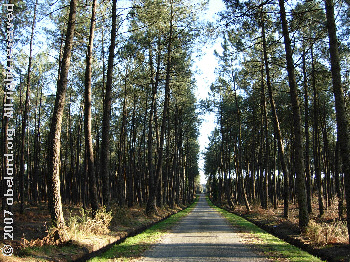 A forest access road in Les Landes, 2007 |
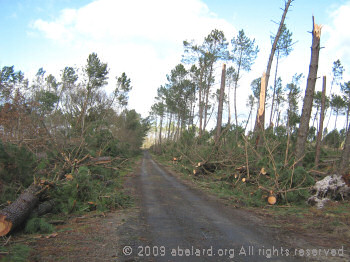 Taken from the same point, late January 2009 Four men with a caterpillar JCB and chainsaws took over eight hours to move fallen pines from this section of road |
||||
 Looking into the industrial pine forest of Les Landes, 2007 |
 Taken from near the same point, late January 2009 |
||||
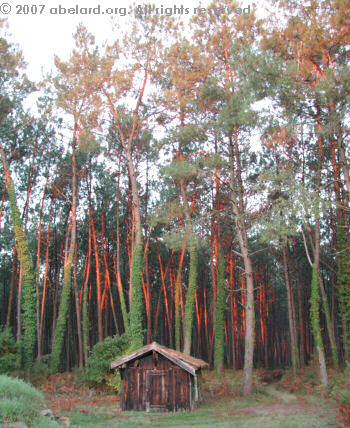
|
Left: A Landais hut sheltered by
30 to 40-year-old pines, |
||||
| And below are pictures of the tragic results of Cyclone Klaus: | |||||
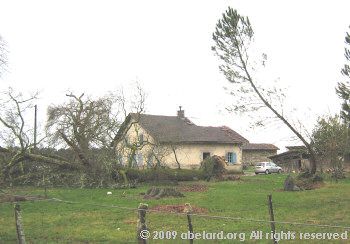 A roof stoved in, with the culprit tree. This house is still abandoned, unrepaired, almost two years later. |
 La nature fragile |
||||
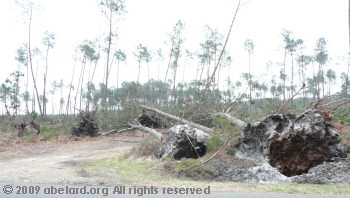 Overturned pines, poorly rooted in Les Landes sand |
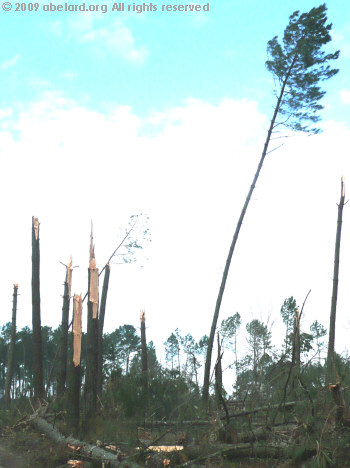 Pines snapped like matchsticks |
||||
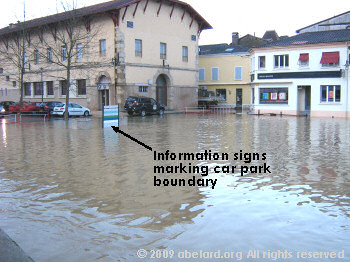 A town car park next to the flooded River Midouze |
|||||
|
|
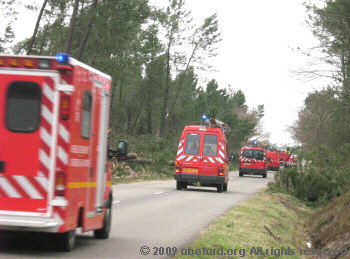 A convey of rescue vehicles |
||||
 A field of matchstick-snapped pines |
|||||
|
|||||
| abstracts | briefings | information | headlines | loud music & hearing damage | children & television violence | what is memory, and intelligence? | about abelard |
|
© abelard, 2009,09 february the address for this document is https://www.abelard.org/france/les_landes_tempete_klaus.php 1230 words |